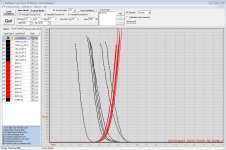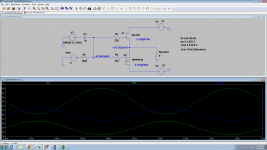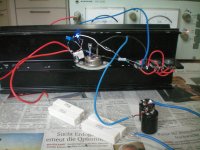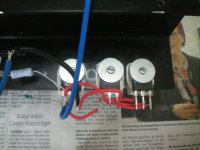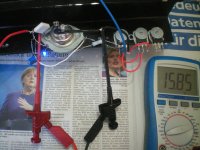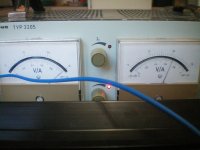In that case the 2 devices with higher Vgs are best.
But then, there is a way described here, which overcomes the differences and offer much more freedom.
By the way, when my Lockyz was still alive, I often controlled the Vgs via a 9V battery and 10k pot, this will leave much more voltage headroom for the measurements.
Ha, that's it!
THX
..........
May I add, I am really a bit embarrassed that SIT-3 can go to the same level.
A PP with a Sit for the pos wave form and a mosfet for the neg part.
How can the wonderful sound of a SIT be there when only the left ear hears the SIT.....
😀😀😀
I have no doubt that SIT-3 sounds wonderful!
But I do not understand it or I can not explain it.
Friend Peter R. alias "pr" read these lines and answered my in a personal mail telling me that not one ear is hearing the SIT and the other the Mosfet....
😀
But...look his friendly and helpful answer I translated with Google, so all faults due to Google.... 😀
"If I understood correctly, you wrote in DiyAudio that the DEF is a mystery. What is the puzzle? May I help?
The MOSFET has a high-impedance drain line, as you can see in the Vds / Id diagram
on the horizontal characteristic (IRFP9240, but not the IXYS MOSFETs):
You can vary Vds a lot, but Id hardly changes, typical pentode characteristics.
The SIT has a low-resistance drain line, which increases Uds / Id characteristic.
This means that changing Vds, Id changes, what is a kind of feedback.
So: The MOSFET has virtually no negative feedback, its Vds is almost arbitrary, the SIT has a negative feedback.
So the SIT responds to the non-linearities of the MOSFET, but the MOSFET does not respond to that of the SIT.
Long story short: the SIT dominates the behavior of the DEF with its character policy."
Wonderful Peter, both ears will hear the SIT!


Last edited:
Funny Gerd
what I posted here : Most Greedy Boy, of them all... or (there is no) DEFiSIT of Papa's Koans
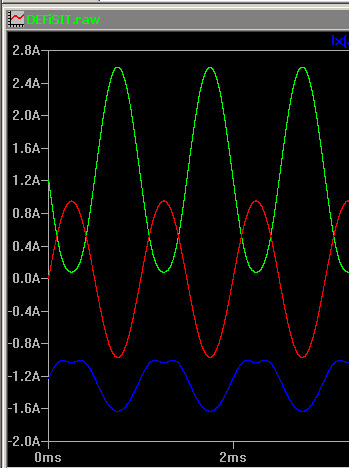
red - current through 8R load
green - current through mosfet (IRFP9140)
blue - current through PapaSit
that's probably of same seriousness as Monty Python's Flying Circus - World's Funniest Joke

(yup, I know - nobody is taking serious pretty much nothing I'm writing ............ )
)
what I posted here : Most Greedy Boy, of them all... or (there is no) DEFiSIT of Papa's Koans
red - current through 8R load
green - current through mosfet (IRFP9140)
blue - current through PapaSit
that's probably of same seriousness as Monty Python's Flying Circus - World's Funniest Joke

(yup, I know - nobody is taking serious pretty much nothing I'm writing ............
 )
)
Last edited:
Funny Gerd
what I posted here : Most Greedy Boy, of them all... or (there is no) DEFiSIT of Papa's Koans

red - current through 8R load
green - current through mosfet (IRFP9140)
blue - current through PapaSit
that's probably of same seriousness as Monty Python's Flying Circus - World's Funniest Joke

I thought it was ART!
😀😀😀
Hi Generg,
Thanks for posting that: The mosfet is largely invariant (pentode), so the SIT dominates the response of the amplifier to any input.
Doesn't it matter that the SIT waveform can look so gnarly?
Thanks for posting that: The mosfet is largely invariant (pentode), so the SIT dominates the response of the amplifier to any input.
Doesn't it matter that the SIT waveform can look so gnarly?
So that is the SITuation..... :--))
Seems I have no P channel IRFP9240 Mofets that have the same data as my SITs. They need all a higher Vgs for 1.5A.
So the method Antoinel suggested will not work, is it right that in his case the R084 had the higher Vgs and therefore he could reduce the voltage for the P MosFET?
Seems I have no P channel IRFP9240 Mofets that have the same data as my SITs. They need all a higher Vgs for 1.5A.
So the method Antoinel suggested will not work, is it right that in his case the R084 had the higher Vgs and therefore he could reduce the voltage for the P MosFET?
Attachments
The Lockyz measures the devices cold.
I would suggest you to try mounting both FETs onto a heatsink, measure manually (give time for them to heat up and stablize) and see what you'll get. The Vgs required for the 9240 to reach the target current will drop quite a bit after heating up.
I would suggest you to try mounting both FETs onto a heatsink, measure manually (give time for them to heat up and stablize) and see what you'll get. The Vgs required for the 9240 to reach the target current will drop quite a bit after heating up.
I have been playing with LTSpice and trying to understand more about the DEF.
Please confirm my understanding:
1. With parts that are perfectly matched and using a symmetric dual rail supply, both parts will pass the same current and the DC voltage at the sources is 0V.
2. The gain of each device is likely not equal and so AC current coming out of the supply rails will be of different magnitudes.
is this accurate?
Please confirm my understanding:
1. With parts that are perfectly matched and using a symmetric dual rail supply, both parts will pass the same current and the DC voltage at the sources is 0V.
2. The gain of each device is likely not equal and so AC current coming out of the supply rails will be of different magnitudes.
is this accurate?
Attachments
I had time so I made some tries with my SIT and some 9240.
When I paralleled two, later three 9240 I got at least 0.5A current running.
My external PSU delivers only 30V and 1A so these tries are more for fun.
Mind that I also invested in a blue LED to get the Pass effect......!
😀😀😀
When I paralleled two, later three 9240 I got at least 0.5A current running.
My external PSU delivers only 30V and 1A so these tries are more for fun.
Mind that I also invested in a blue LED to get the Pass effect......!
😀😀😀

Attachments
Seems I have no P channel IRFP9240 Mofets that have the same data as my SITs. They need all a higher Vgs for 1.5A.
If the difference is not very high, then using some small resistance in series
with the P channel Source is acceptable, and lowers the 2nd harmonic if that's
what you want.
Thank you Mr. Pass for helping and keeping us busy with new ideas to experiment!
Today I made some changes, other SIT, the one from yesterday was more in the middle of my ballpark. Now I took one with higher Vgs. No more the THF-51 but SK182E.
Results are now much better, still two 9240 parallel.
I can reach with 30V the 1.4A without problems.
Now I heat the heatsink.....
And many thanks to ZM for his generous presentation of Nelsons gift all over the thread and to Antoinel too, doing so much good research for the DeFSIT in his thread.
First picture shows the changed SIT and the two doubled IRFP9240.
Second pictures shows the voltage 30V and the current value, with 0.7A.
You must double it, I choose 30V 2A adjustments at the PSU.
Old gear from the former DDR.... :--))
😀😀
Today I made some changes, other SIT, the one from yesterday was more in the middle of my ballpark. Now I took one with higher Vgs. No more the THF-51 but SK182E.
Results are now much better, still two 9240 parallel.
I can reach with 30V the 1.4A without problems.
Now I heat the heatsink.....
And many thanks to ZM for his generous presentation of Nelsons gift all over the thread and to Antoinel too, doing so much good research for the DeFSIT in his thread.
First picture shows the changed SIT and the two doubled IRFP9240.
Second pictures shows the voltage 30V and the current value, with 0.7A.
You must double it, I choose 30V 2A adjustments at the PSU.
Old gear from the former DDR.... :--))
😀😀
Attachments
Heating up, the voltage at the sources remains very stable at 15,88V.
Changes are very small around 10mV.
So I am happy today... :--))
Changes are very small around 10mV.
So I am happy today... :--))
I wanted to hear if the circuit does music.....🙂
So I used no J-Fet frontend and no Cinemag but only a 220uF Silmic for the gates of the semis.
All gain from the preamp.
Yes it can play music....😀
A bit dark, maybe the SK182E are no E but only 182 and have very high input capacity and Crss.
So I will try to get the system running with the THF-51 as well.
Besides the dark and a bit soft character..... it sounds really good under worst conditions.
Only 30V, no stable class A PSU no input buffer and so on.
So I used no J-Fet frontend and no Cinemag but only a 220uF Silmic for the gates of the semis.
All gain from the preamp.
Yes it can play music....😀
A bit dark, maybe the SK182E are no E but only 182 and have very high input capacity and Crss.
So I will try to get the system running with the THF-51 as well.
Besides the dark and a bit soft character..... it sounds really good under worst conditions.
Only 30V, no stable class A PSU no input buffer and so on.
:--))
Interesting the dark sound I mentioned was the consequence of doubling two IRFP in parallel.
Transconductance doubled? So taking only one the sound got more defined and less k.2 dominant.
But Helas, I could not get again the 1.4A but only 1.2A.
So I have still to look for the right partnership! Maybe not Angela....:--))
Interesting the dark sound I mentioned was the consequence of doubling two IRFP in parallel.
Transconductance doubled? So taking only one the sound got more defined and less k.2 dominant.
But Helas, I could not get again the 1.4A but only 1.2A.
So I have still to look for the right partnership! Maybe not Angela....:--))
Astonishing, such a small circuit and no plop noise when switching on and switching off...
I can only shake head....what is possible when you are tricky like Nelson
:--))
I can only shake head....what is possible when you are tricky like Nelson
:--))
Congratulations, and when you increase the rail to 35V you'll probably get more current also.
BTW, I just found that my 2SK180D pair well with 2SJ56, both give around 1.35A when Vgs=-2.9V and Vds=16V, though I'm not sure if Lateral FET is a good idea in this output stage.
BTW, I just found that my 2SK180D pair well with 2SJ56, both give around 1.35A when Vgs=-2.9V and Vds=16V, though I'm not sure if Lateral FET is a good idea in this output stage.
- Home
- Amplifiers
- Pass Labs
- Most Greedy Boy, of them all... or (there is no) DEFiSIT of Papa's Koans

